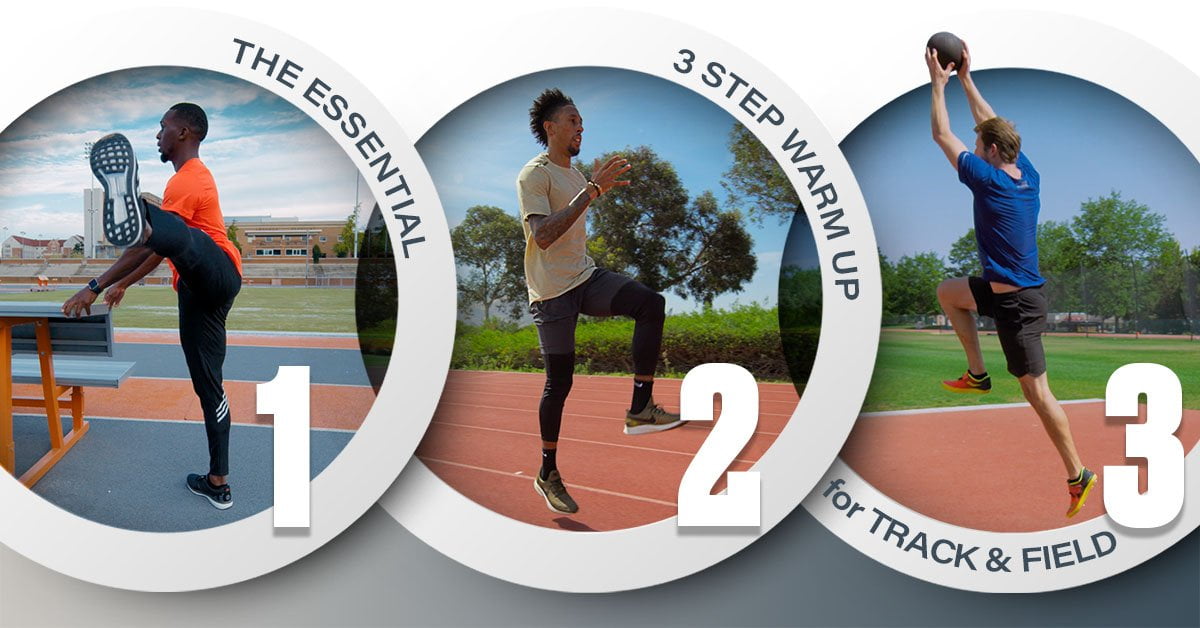
This is a complete guide to the most effective high jump workouts and drills.
From reinforcing proper movement patterns to developing speed and explosiveness, these workouts and drills will help you take your high jump skills to the next level.
Optimal high jump training requires specific drills and workouts that meet the unique demands of the event.
Relying solely on traditional power and speed drills and jumping repetitions won't get the job done.
The most effective high jump workouts incorporate a range of drills that reinforce proper mechanics and high jump technique throughout each phase of the jump, in addition to developing speed and explosiveness.
And that's exactly what this guide is all about.
You'll learn the training methods and drills proven to deliver results, step-by-step.
Many of these drills can be performed at home or without a mat, making them accessible throughout the year.
All of the workouts we’ve included can be tailored to individual needs and skill level using the information in this guide
So whether you're a seasoned track coach looking for new ideas or a beginner jumper in your first track season, these drills, and workout strategies will provide you with essential tools to add to your training arsenal.
Let's jump in.
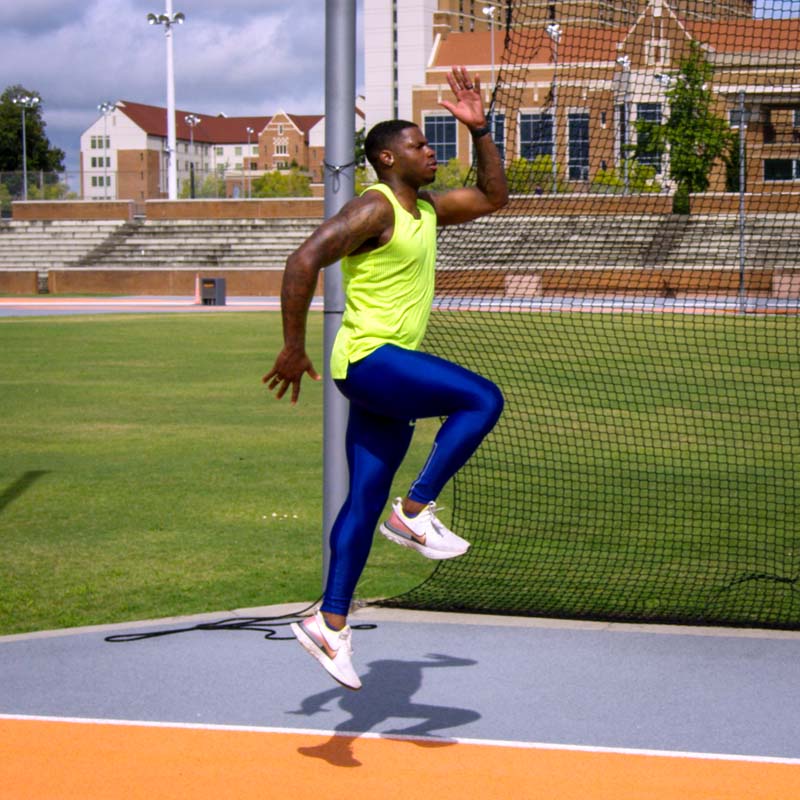
Crucial High Jump Training Concepts
This section is the 'why' of the guide.
Before getting into the specific drills and techniques for high jump training, it's essential to understand the underlying concepts and principles that drive improved performance.
In this section, you'll get a comprehensive overview of high-level concepts to help you build a strong foundation of knowledge.
Not only will this help you become a more informed coach or athlete, but it will also allow you to tailor your training to your individual needs and goals for maximum results.
You can certainly skip ahead to the high jump workouts and drills section.
However, if you to take the time to understand these concepts they will pay dividends in your long-term success in the high jump.

Training the Nervous System
You can't think your way through the jump.
When an athlete performs the high jump, their body must coordinate multiple muscle groups precisely and efficiently to generate the necessary speed, power, and height to clear the bar.
Studies have shown that neuromuscular function (how the muscles and nerves work together) is far more important than strength and power when it comes to sprinting and high jump performance.
By training the nervous system to ingrain proper movement patterns, athletes can develop muscle memory and coordination that enables them to execute proper high jump technique without thinking.
This is especially important during track meets when the pressure is on, and the adrenalin is flowing.
Successful high jumpers trust their body. And the way to develop that trust is by practicing the correct movements until they become second nature.
Another way to develop confidence and prepare for track meets is through mental practice.
Once high jumpers have learned the correct technique, they can visualize themselves successfully performing the movements.
This approach has been scientifically proven to be effective, as research shows that mental rehearsal activates the same neural pathways as physical practice.
In the video below we've slowed down the jump by 2000% which makes it easier to see just how complex the high jump is.
Single Leg Power
It's a one-leg event.
Single-leg power is a crucial aspect of high jump training.
After all, there isn't a single phase of the jump when both feet are on the ground simultaneously.
Each stride, from the approach to the takeoff, is performed on one leg.
High jump workouts that mirror this type of specificity increase performance.
Additionally, studies have shown that single-leg training can dramatically improve balance, coordination, and power while reducing muscle imbalances and the risk of injury.
One study found that high jumpers who performed single-leg training significantly improved their high jump performance compared to those who did not.
That's not to say you should skip the squats and box jumps. They certainly have their place in high jump workouts.
However, to succeed in the high jump, you must prioritize developing single-leg power with movements that simulate the speed, force, and ground contact times of the event. Mastering fundamental sprinting drills is a great place to start.
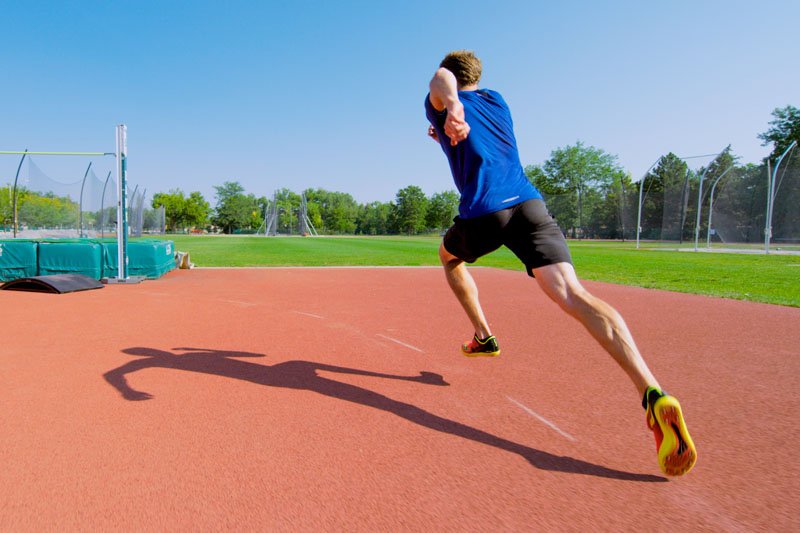
Core Strength
It's more than six pack abs.
A strong and stable core allows an athlete to maintain proper posture and body position during the jump's approach, takeoff, and flight phases.
Research has shown that core strength is essential to maximize power, efficiency, and overall performance.
Keep in mind that a strong core is more than six-pack abs.
You must develop deep muscles that you can't show off in your bathing suit.
The deep muscles of the core include the transverse abdominis, the multifidus, and the pelvic floor muscles.
These muscles are located deep within the abdominal cavity and play a key role in stabilizing the spine and pelvis and maintaining proper posture and body alignment.
In the video below coach Ryan Baily gives some great insight on core stability for jumpers.
A quick anatomy lesson that directly relates to high jump training.
The transverse abdominis is a deep abdominal muscle that wraps around the midsection, providing support and stability to the spine and pelvis. Properly executing the Fosbury Flop requires this muscle group to be strong and flexible.
The multifidus is a small, deep muscle that runs along the spine and is crucial for maintaining proper posture and stability in the vertebrae during the jump.
Despite its importance, coaches and athletes often overlook training the multifidus.
If you are experiencing lower back pain, chances are that activating and strengthening the multifidus will be the fastest road to recovery.
The pelvic floor muscles are a group of muscles that run from the pubic bone to the tailbone.
Strong pelvic floor muscles support the upper body's weight and provide a stable base for the lower body to push off from during the jump.
They also improve posture and stability, which is vital for maintaining balance and control during the high jump.
Together, these deep core muscles reduce "slack in the system" and ensure that the force you apply to the runway translates into speed and height.
A weak core absorbs power generated from the legs and diminishes performance.
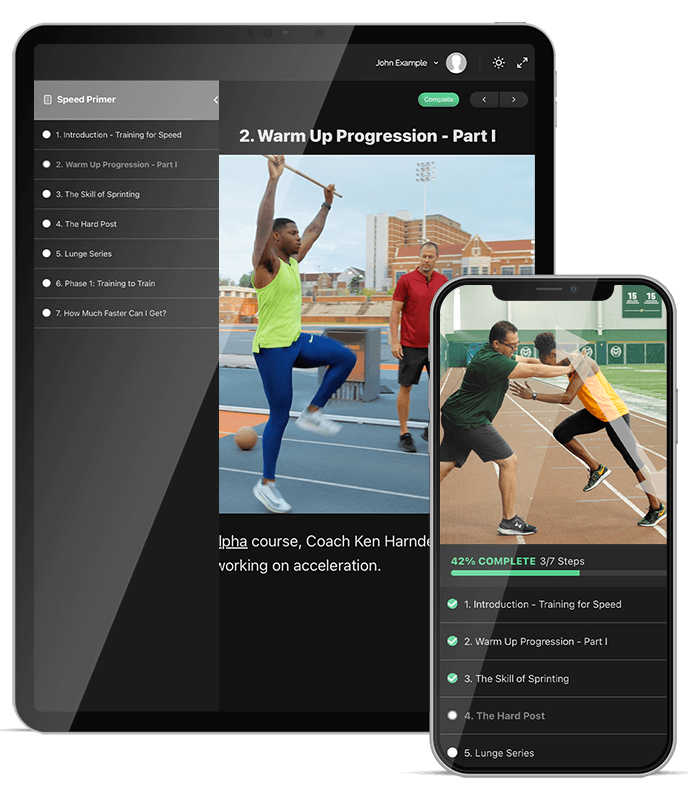
High Jump Warm-Up Drills
A proper warm-up is key for the high jump.
Just jogging a few laps and throwing in some static stretching isn't going to cut it.
The warm-up exercises we've provided here will prepare the body and nervous system for the specific demands of the event.
They'll also help to develop proper sprinting form.
If you're looking for high jump drills without a pit, you'll be happy to know these exercises will improve strength, technique, and focus, all without a mat.
Drill #1 - Drop Squat Into Skip
Why it works: Both drop squats and skips are fantastic movements to prepare the body for more intense training.
Combining them provides additional advantages of improved coordination, proprioception, and getting the heart rate up.
Drill 2 - Quick Legs
Why it works: This drill is excellent for improving sprinting mechanics because it allows the athlete to focus on one leg at a time.
It also helps to clean-up backside mechanics by targeting the 'z' position, a critical component for maximizing force production.
Drill 3 - Burnouts
Why it works: Not only is this drill fantastic for warming up the feet and ankles, but when performed with a med-ball, it develops stability throughout the entire body.
Additional Recommended Warm-Up Drills
- A skips and B skips
- Lunge series
- Straight leg bounds
- Dynamic stretches - leg swings, shoe sweeps, arm circle walks
- Glute Activation - glute bridges, fire hydrant, side leg raises
Core Exercises
The following exercises target all of those deep core muscles we discussed previously.
They also activate the nervous system and prepare the body for more dynamic movements.
To top it all off, these drills are fantastic for high jump workouts at home.
Drill #4 - Split Lunge Jump
Why it works: This drill helps athletes avoid one of the biggest mistakes in high jumping - letting the torso drop over the hips.
Adding some weight in front of the athlete allows them to feel what it's like to keep the torso straight and hips engaged.
Split lunge jumps also fantastic for building strength and coordination.
Drill #5 - Dead Bug
Why it works: The dead bug is one of the best exercises for activating and strengthening the multifidus, a key stabilizer of the spine.
Adding the arm and leg movement makes it even more specific to jumping while strengthening additional stabilizers.
Drill #6 - Side Plank Crunch
Why it works: The side plank crunch requires balance and stability, which will directly carry over to the high jump.
This drill also works the obliques and the other deep core muscles needed for proper posture.
Additional Recommended Core Drills
- Forearm Plank
- Mountain Climbers
- Russian Twists
- Bear Crawl
- Reverse Swimmers
the most effective high jump course online.
Explore CourseJumping Technique/Dynamic Drills
The following drills are more ballistic and should be performed after the athlete is thoroughly warmed up.
They work on specific aspects of the jump from the takeoff to rotation over the bar.
Drill #7 - 2 Step Takeoff
Why it works: By practicing two-step takeoff drills, high jumpers can develop a consistent and efficient technique for their takeoff.
Incorporating a med-ball provides an additional boost by improving explosive power balance and coordination.
Drill #8 -Backovers
Why it works: The backover requires an athlete to move through a full range of motion, which can help to improve the flexibility in the hips, spine, and shoulders.
It also mirrors the Fosbury flop, so it's one of the best high jump drills for beginners that still need to develop spatial awareness when clearing a bar.
Drill #9 - Glute Bridge Drop
Why it works: This drill takes the glute bridge to the next level regarding dynamics and carry-over to the event.
Static exercises are are beneficial, but the high jump isn't a static event.
In addition to building glutes and core strength, this drill helps develop comfort with landing on the shoulders in the mat.
Additional Recommended Jumping Technique/Dynamic Drills
- Circle Jumps
- Box Drills
- Five Step Half Circle Jumps
- Circle Drill with Hurdles
- Alternate Bounds for Distance
High Jump Workouts
Below are 9 high jump workouts.
They are selections from Coach Ryan Baily's awesome course and program Smarter Jumps Training.
We’ve organized them to represent what a training week would look like, so you’ll see recovery and rest days built into the schedule.
This high jump workout plan and training schedule is a solid starting point for most athletes.
However, the individual workouts, training sequence, and volume can be modified depending on the jumper and their response to the training.
General Preparation/Early Pre-Competition Phase Workouts
| Workout Number | Workout Details |
| Workout #1 | Training Preparation 3 x (133m @ 50% Effort, Skip 133m) ^Between Each, Core Complex 1 + Dynamic Drills Speed (Hard Post Drills) 3 x 30m Accelerations High Jump Drills 3 x Circles (Draw at 17’6” Radius) 3-5 Lunge Jumps Workout 2-3 x Sandpit Circuit |
| Workout #2 | Training Preparation Split Up Core Complex 2 ^Between Each, Stride 50/Skip 50 +Dynamic Drills & Hurdle Hip Mobility Speed 3 x 20m Mini Hurdles (Form Running) High Jump Drills 3 x Two Foot Jog-in Back-overs 3 x 4ES Alt. Bounds for Distance Workout 3 x (4 x 40m Sprints w/ 20 Sec Rest) ^Between Each, Stair Combo |
| Recovery | Pool Recovery |
| Workout #3 | Training Preparation 3 x (133m @ 50% Effort, Skip 133m) ^Between Each, Core Complex 1 + Dynamic Drills Speed 3 x Light Sled at 75% Effort High Jump Drills 3 x Back-Overs on Tall Box 3 x 3-5 Step Off of Incline Workout 6-8 x 60m 4-6% Grade Hill |
| Workout #4 | Training Preparation Split Up Core Complex 2 ^Between Each, Stride 50/Skip 50 +Dynamic Drills Speed 2 x 40m Strides Workout 2 x 5 x 100m On 60 sec @ 60% ^Between Each Med Ball Circuit: 10x Slam Downs 10 x Med Ball Push Ups (5 Each Side) 10 x Med Ball High Toss |
| Workout #5 | Training Preparation 600-800m Jog Dynamic Drills 2 x 40m Strides Workout 6 x 100m Hills 3-4% Grade Hill (Dirt or Grass) Walk Down |
| Rest | Rest |
Pre-Competition/Competition Phase
| Workout Number | Workout Details |
| Workout #6 | Training Preparation 3 x (133m @ 50% Effort, Skip 133m) ^Between Each, Core Complex 1 + Dynamic Drills 1 x Mini Hurdle Stability/Coord Drills Speed 3 x 20m Accelerations High Jump Drills Full Approach Work Only |
| Workout #7 | Training Preparation Split Up Core Complex 2 5 x Plate Clean & Jerks ^Between Each, Stride 50/Skip 50 +Dynamic Drills Speed 2 x 40m Strides High Jump Drills Light Technique Workout 6 x PMR Circuit (All on Grass) ^Between, Stride 30/Skip 30 |
| Recovery | 25 Min Elliptical 2 x Core Complex 1 & 2 |
| Workout #8 | Training Preparation 3 x (133m @ 50% Effort, Skip 133m) ^Between Each, Core Complex 1 + Dynamic Drills Slam Ball Circuit 1 & 2 Speed 2 x 40m Strides High Jump Drills A Few Back Overs A Few Circle Jumps off Ramp 3-Steps / Ladders |
| Workout #9 | Training Preparation Split Up Core Complex 2 ^Between Each, Stride 50/Skip 50 +Dynamic Drills Med Ball Circuit: 10 x Slam Downs 10 x Med Ball Push-Ups (5 ES) 10 x Med Ball High Toss *Workout 6 x Power Circuit: 12 x Bleacher Jumps 20m Sprint, 20m Deceleration Straight Leg Bound *Meet Prep Reduce volume on training prep Replace workout with light technique work Also applies to workout #8 Athlete should be fully recovered prior to key track meets |
| Rest/Meet | Rest or Meet |
| Rest | Rest |
Determining Proper Training Volume
The proper high jump training volume can vary depending on several factors, including the athlete's age, experience, physical abilities, and individual response to training.
It is essential to find a balance between providing enough training stimulus to improve performance and avoiding overtraining and burnout.
To determine the proper volume of training for the high jump, here are some primary factors coaches and athletes should consider:
- Physical abilities: Optimal training volume is highly individual and does not necessarily increase with experience, performance or age. Every athlete is unique in their response to training and the amount of stimulus needed to maximize their performance. Like medicine, the goal here is the minimal effective dose.
- Training cycle: The time of year will be a big factor in overall volume. For example, most athletes will have a much higher workload during the general preparation and pre-competition phases compared to the competition phase. You can't really improve your jumping performance three-days-out from a meet, but you can certainly hurt it.
- Recovery and stress levels: Even though training is a positive stress, it's still a stress. So it's important to remember that stress is something that everyone has a finite capacity to handle. If an athlete is experiencing stressors outside of training (i.e. during finals week), they may need to reduce the training volume or add additional recovery strategies.
The Power of Rest and Recovery
It's important to remember that training provides the stimulus for the body to adapt and become stronger, faster, and more efficient.
The magic happens during rest and recovery because that is when the body actually makes the adaptations and improvements that lead to enhanced performance.
This is why it is so crucial for athletes to incorporate regular periods of rest and recovery into their training programs.
Recovery weeks allow the body to rest, repair, and adapt to the intense training performed in the preceding weeks.
By allowing the body adequate time to recover, athletes can optimize their performance and reduce the risk of overtraining and injury.
Every fourth or fifth week should be a recovery week in a well-formulated high jump training program.
These weeks should be planned and built into the training schedule.
By reducing the intensity, volume, or both during these weeks, you can help to prevent overtraining and reduce the risk of injury.
During a recovery week, it is essential to still engage in training, but at a lower intensity and volume.
Activities like pool workouts, yoga, or foam rolling can help improve mobility and reduce muscle soreness.
Throughout the year it's important to ensure that you are fueling your body with a healthy and balanced diet and getting enough sleep to support recovery.
In addition to the physical benefits, recovery weeks can also provide a mental break from training demands and help athletes stay motivated and focused in the long term.
By scheduling recovery weeks into your training program, you can optimize your performance and maintain the passion needed to achieve your long-term goals in the high jump.
Conclusion
So that's it for our guide to high jump workouts and drills.
Now we'd like to hear from you.
What drills and training routines are you going to implement first?
Are you going to start doing more core exercises?
Did we miss any drills or training strategies that have really worked for you?
Either way, let us know by leaving a comment below.
To learn more about maximizing your high jump workouts, check out Smarter Jumps Training.

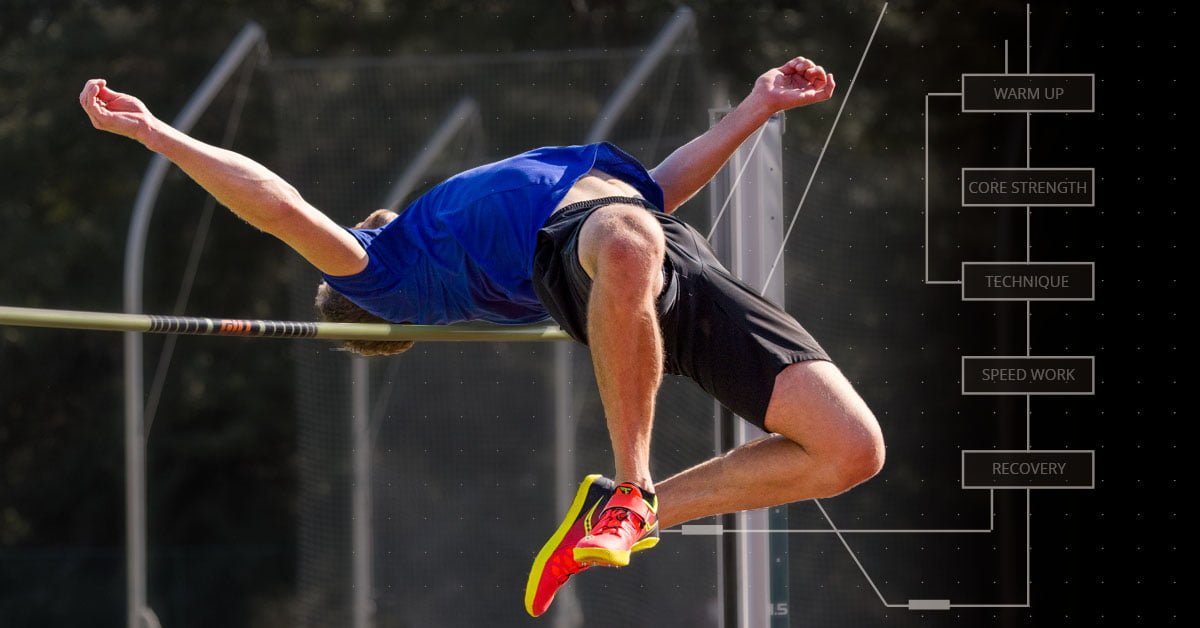
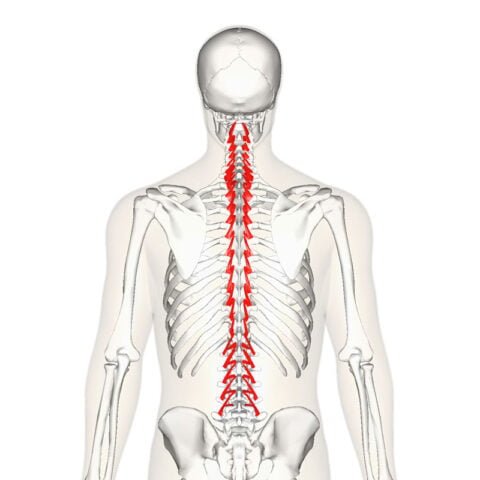
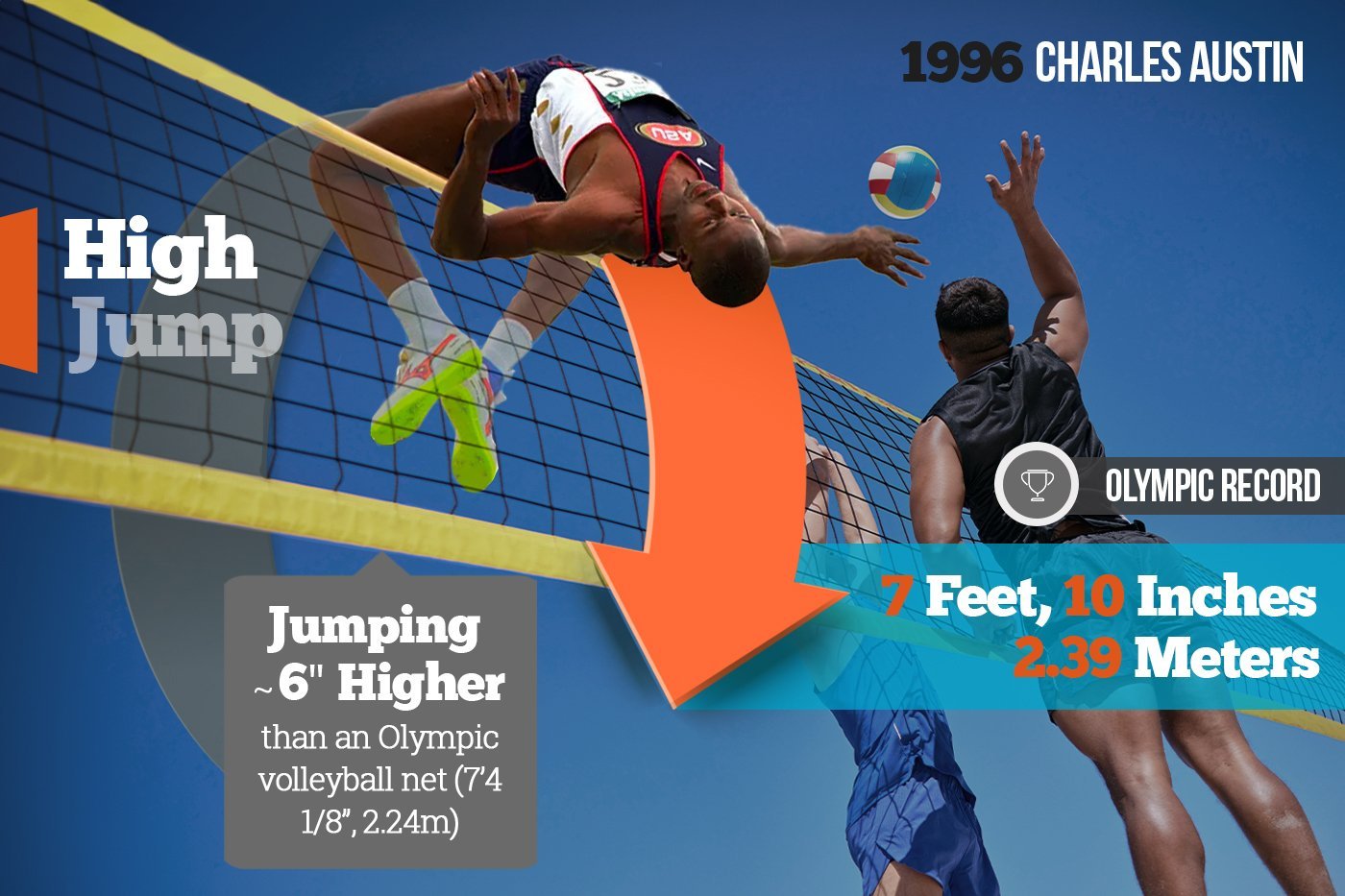
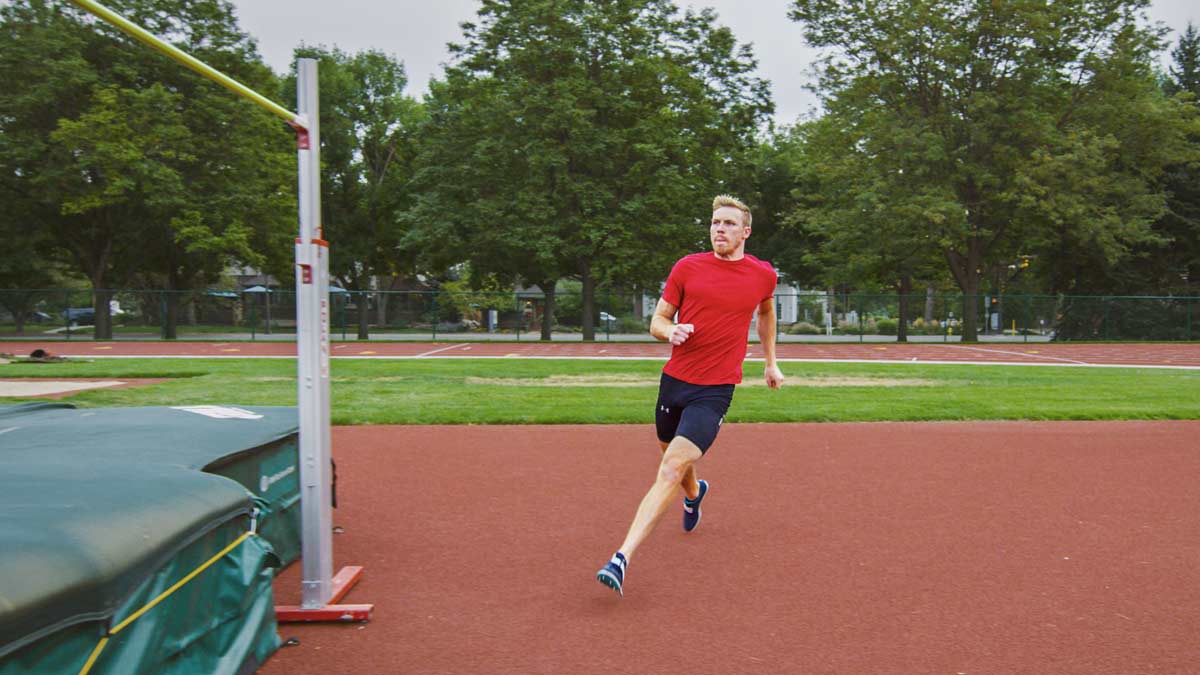
Great info. Really like the high jump med ball drills, esp the 2 step take off. Question: how are you developing speed/sprint mechanics in your athletes? I've got a jumper in his senior year that seems to be stuck at ~6' 7" I'm certain he could go at least 6'10" with a better approach.
Appreciate it Ron. Incorporating speed work and warm-up drills that develop sprinting mechanics and form is key. Check out the article we posted on sprinting form
Dialing in the approach is also critical, you might want to check out our Jumping Smarter, Jumping Higher course. It really goes into how to set up an optimal approach for each athlete. Good luck this season!
My name is Antonio an I'm eager to buy This course next month, I'm a little bit concerned because I don't speak English 100% but i can't wait. Thank you very much for share this knowledge with all os us.
Greetings from Mexico city!
How do I train a child that never jumped before
Starting with a child who's new to high jumping is all about building their basic athletic abilities first, like running, balance, and coordination, through fun activities. Initially, focus on teaching them simple jumping and running mechanics before moving onto high jump specifics. Basic sprinting drills like A-Skips and high knees will establish proper movement patterns early and will be a huge advantage in the long run (even at the high school and college level, most athletes are missing this critical foundation).
For high jumping, begin with low heights to ease them into the technique without pressure, emphasizing fun and encouragement to build confidence. Drills like back overs are great here. Getting comfortable landing on the mat should be a big priority. As they improve, gradually introduce more complex skills and increase the height, always prioritizing safety and correct landing techniques. Start with very short approaches and gradually add steps. Feel free to reach out if you need more detailed guidance or have specific questions. Good luck on this rewarding coaching journey!
Teaching High Jump drill for beginner high
What kind of warm up high jump drills are recommended for the day of the meet?